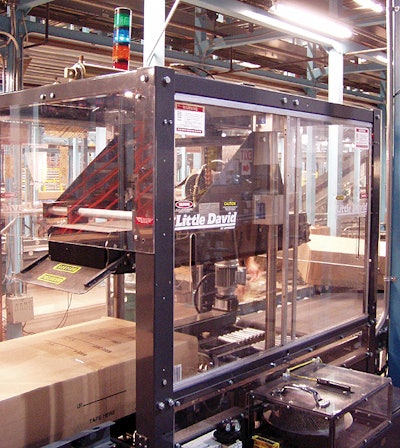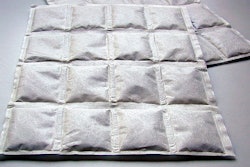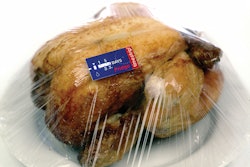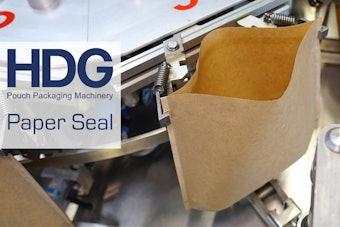
The process for packing and shipping orders from Liz Claiborne’s distribution center at Mt. Pocono, PA, has taken a major leap forward, thanks to the addition of specially designed box-taping machines for individual parcels.
The taping systems, Model 16R machines from Loveshaw, an ITW company, were outfitted with a custom taping head in June 2004 to complete what had been a two-year project.
Although the Mt. Pocono center is called the “flagship” distribution center for Liz Claiborne, Inc., New York, newer centers in Claiborne’s network had already moved into more modern, more automated packaging. At the start of the project, the Mt. Pocono center was using gummed paper tape that was manually applied to its four different sizes of shipping containers. So its operation was not only slow, it was labor-intensive.
When company engineers looked to find a solution for the Mt. Pocono plant, their first stop was at another company distribution center in Cincinnati. “That center had been using Loveshaw packaging equipment for two years. We figured it would be a good place to start, and potentially a nice fit for us as well,” says Guy Bettelli, outbound operations manager at Mt. Pocono.
Working with its distributor, Unisource, Loveshaw began to look at a random case taper that would work in the facility. Eventually, the distribution center added three Little David Model 16R sealers that would work well, even at the 130’/min speed of the center’s packaging lines.
But the Cincinnati location uses regular-slotted-containers (RSCs), while Mt. Pocono’s facility was built to accommodate one-piece, fold-over clamshell or “pizza-style” corrugated boxes. That’s why the Little David machines needed the special taping head.
Applies five tape strips
The case tapers at Mt. Pocono randomly capture filled boxes, apply some top pressure via a hold-down belt, and apply two L-clips of tape to both the front and trailing edges, along with a long strip of tape parallel to the longest seam of the box, all at 10 boxes/min.
When the sealers were first installed, the distribution center switched from gummed paper tape to a 3-mil plastic security tape from Unisource that’s randomly printed with the Liz Claiborne logo and a message warning stores to look for packaging that’s been tampered with.
Because of the speed of the case-sealing line, Loveshaw faced challenges in applying the tape and cutting it. “One issue was applying tape at 130 feet-per-minute without the tape pulling or sliding off the box,” says Bryce Fox of Loveshaw. “The other challenge was consistent cutting of the tape.
“We created a new tape cartridge with a built-in brake that varies the tension of the tape. The design of the brake eliminates tension as the tape is being applied and then reapplies tension for cutting it. For these lines, tape application couldn’t be consistent with a single tension setting.”
In addition, Loveshaw had to change the amount of pressure that activated the leading-edge kicker because some boxes were not rigid enough and could become damaged. As well, the mechanical clamshell it used to wipe down the L-clips on the trailing edge was having trouble keeping up with the line speed. “A pneumatic wipe-down device activates much more effectively,” Fox says.
Previously, the distribution center applied the paper tape manually, using some 18 workers on two shifts for outbound boxes. “Since we added the new equipment, we’ve reduced our labor to six people across two shifts,” says Christine MacDonald, an industrial engineer at Mt. Pocono.
Part of the key to the output improvement is training of packers, who select one of four box sizes to package each order, or a part of it. “Occasionally, our boxes can be overfilled and they may bulge a bit,” MacDonald says. “The compression head on the sealing machine helps reduce bulging, but we don’t want it to apply too much pressure. Overfilling of boxes can make stacking more difficult, so we work hard to train the box packers to select the right sizes.”
Pacing the line
In the 1.2 million sq’ facility, all orders are picked and sent to one of three bomb-bay sorters that all products funnel through, MacDonald explains. Lights alert operators when an order is ready to be packed off. That’s when the operator selects the box size and sets the box up. Three of the boxes measure 20 x 35.5” with heights of 4”, 7” and 9.” The smallest container measures 14.5 x 26.5 x 3”.
As the garments and other products are being packed into the box, each item is scanned by a radio-frequency scanner and a generic bar-code label is applied. To avoid downstream problems, the operator applies what it calls a “belly strap” to the box to keep the box closed as it enters the sealing system. In addition, the operators apply a small L-clip of tape to the trailing left-hand corner. “We learned that when the compression head applies pressure to the top of the box, occasionally that flap would release,” MacDonald points out.
From the packing station, the box is released onto a gravity conveyor that feeds a powered conveyor leading to the case-sealing system. After the five pieces of tape have been applied, the box continues towards an existing print-and-apply label station. At this station, the bar code is scanned to trigger the label printer. It prints and then an applicator applies the new label with the UCC 128 bar code. In addition, Dino Mallozzi, director of operations, says this two-year-old station can also be used to apply an extra carton-contents label, if the order calls for it.
On to shipping sorter
Once the boxes have been labeled, they are conveyed on to the Mt. Pocono shipping sorter. It scans the bar code and directs the box to the appropriate shipping chute that leads to one of the outbound loading docks. For some carriers, Mallozzi says, an extra tracking label may be applied.
Mt. Pocono ships via a variety of common carriers, all selected by the various customers, based on routing needs. In fact, some of the orders are actually “pack and hold,” where boxes are racked for later shipment. Regardless of the carrier, Mallozzi says, parcels typically are floor-loaded into the trucks. “Although we stage our loads on pallets, virtually all of our loads are ‘live’ loads, where we load from floor to ceiling,” Mallozzi points out.
“Where six to eight thousand boxes per day used to be a challenge for the center,” Mallozzi says, “now we’re packing and shipping ten to twelve thousand boxes pretty effortlessly.”
This automation also has helped streamline the operations flow, he adds. “When boxes are released from the packing stations, you tend to create bottlenecks. This random tape-sealing system creates a more even flow to labeling and shipping, so it helps eliminate ‘bubble points,’” Mallozzi points out.
“Everyone—Claiborne, Loveshaw and Unisource—learned a great deal on this project,” says MacDonald. “Loveshaw did a lot of operator and mechanic training, and we did a ‘train the trainer’ program, where our supervisors learned about the equipment and they can train replacement operators and mechanics.”
The facility has a maintenance plan for the system that includes daily cleaning and checking of knives, she says. “So long as we keep up with regular maintenance, we haven’t seen any problems with the equipment.”





















